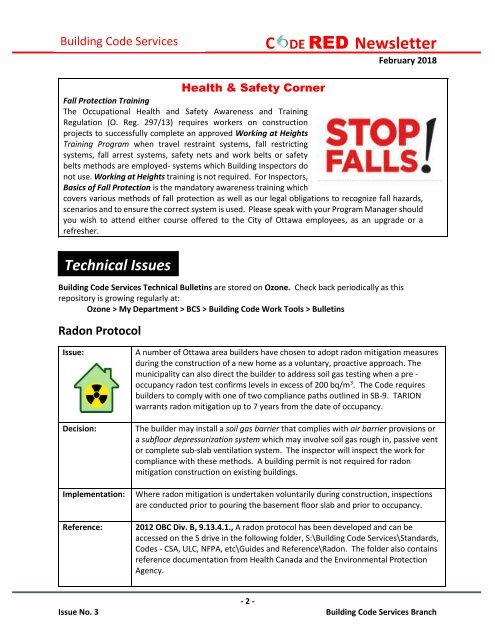CodeRed 3 0draft2018.feb
Create successful ePaper yourself
Turn your PDF publications into a flip-book with our unique Google optimized e-Paper software.
Building Code Services<br />
Branch<br />
C<br />
DE RED Newsletter<br />
February 2018<br />
Health & Safety Corner<br />
Fall Protection Training<br />
The Occupational Health and Safety Awareness and Training<br />
Regulation (O. Reg. 297/13) requires workers on construction<br />
projects to successfully complete an approved Working at Heights<br />
Training Program when travel restraint systems, fall restricting<br />
systems, fall arrest systems, safety nets and work belts or safety<br />
belts methods are employed- systems which Building Inspectors do<br />
not use. Working at Heights training is not required. For Inspectors,<br />
Basics of Fall Protection is the mandatory awareness training which<br />
covers various methods of fall protection as well as our legal obligations to recognize fall hazards,<br />
scenarios and to ensure the correct system is used. Please speak with your Program Manager should<br />
you wish to attend either course offered to the City of Ottawa employees, as an upgrade or a<br />
refresher.<br />
Technical Issues<br />
Building Code Services Technical Bulletins are stored on Ozone. Check back periodically as this<br />
repository is growing regularly at:<br />
Ozone > My Department > BCS > Building Code Work Tools > Bulletins<br />
Radon Protocol<br />
Issue:<br />
Decision:<br />
Implementation:<br />
Reference:<br />
A number of Ottawa area builders have chosen to adopt radon mitigation measures<br />
during the construction of a new home as a voluntary, proactive approach. The<br />
municipality can also direct the builder to address soil gas testing when a pre -<br />
occupancy radon test confirms levels in excess of 200 bq/m 3 . The Code requires<br />
builders to comply with one of two compliance paths outlined in SB-9. TARION<br />
warrants radon mitigation up to 7 years from the date of occupancy.<br />
The builder may install a soil gas barrier that complies with air barrier provisions or<br />
a subfloor depressurization system which may involve soil gas rough in, passive vent<br />
or complete sub-slab ventilation system. The inspector will inspect the work for<br />
compliance with these methods. A building permit is not required for radon<br />
mitigation construction on existing buildings.<br />
Where radon mitigation is undertaken voluntarily during construction, inspections<br />
are conducted prior to pouring the basement floor slab and prior to occupancy.<br />
2012 OBC Div. B, 9.13.4.1., A radon protocol has been developed and can be<br />
accessed on the S drive in the following folder, S:\Building Code Services\Standards,<br />
Codes - CSA, ULC, NFPA, etc\Guides and Reference\Radon. The folder also contains<br />
reference documentation from Health Canada and the Environmental Protection<br />
Agency.<br />
Issue No. 3<br />
- 2 -<br />
Building Code Services Branch


